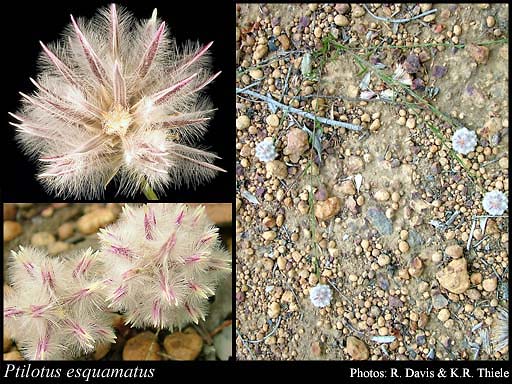- Reference
- Syst.Census Austral.Pl. 28 (1882)
- Conservation Code
- Not threatened
- Naturalised Status
- Native to Western Australia
- Name Status
- Current
Perennial, herb, 0.05-0.2(-0.6) m high. Fl. green-pink/green-white, Nov to Dec or Jan. Sandy clay.

Scientific Description
Perennial herbs, stems several, more or less prostrate, glabrescent or glabrous, with nodose hairs. Leaves present, 5-45 mm long, 1-4 mm wide, glabrescent or glabrous, with nodose hairs; basal rosette present; cauline leaves alternate. Spikes pink or magenta, ovoid or spherical, solitary, with densely arranged flowers. Bracts (6.2-)6.6-7(-7.5) mm long, coloured, hairy, awned or mucronate or not awned or mucronate, with a prominent midrib. Bracteoles (6-)6.5-7(-7.2) mm long, coloured, hairy, awned or mucronate, with a prominent midrib. Outer tepals 9-12.5(-14) mm long, entire. Inner tepals 7.5-12(-13.2) mm long, with a basal tuft of hairs on inner face. Style (3.6-)3.7-3.9(-4) mm long, curved or straight, centrally or obliquely fixed to ovary. Seeds (2.5-)2.6-2.7(-2.8) mm long, glossy or dull, orange or pale brown. Distribution: South West Botanical Region; IBRA regions: Swan Coastal Plain, Jarrah Forest.
Distribution
- IBRA Regions
- Jarrah Forest, Swan Coastal Plain.
- IBRA Subregions
- Northern Jarrah Forest, Perth.
- Local Government Areas (LGAs)
- Armadale, Canning, Chittering, Gosnells, Harvey, Kalamunda, Mundaring, Serpentine-Jarrahdale, Swan, Toodyay, Wandering, Waroona.